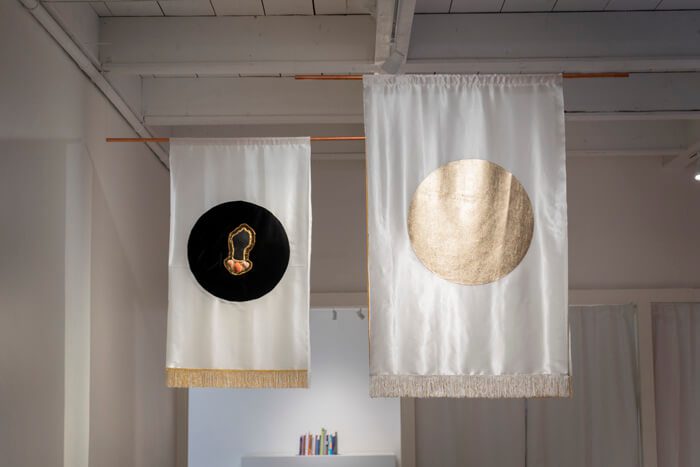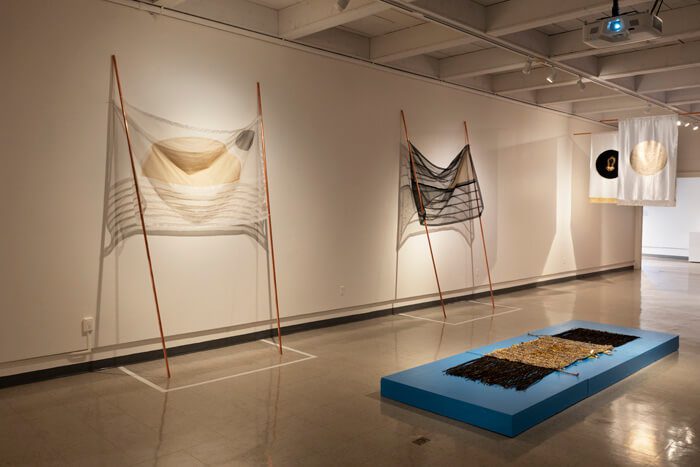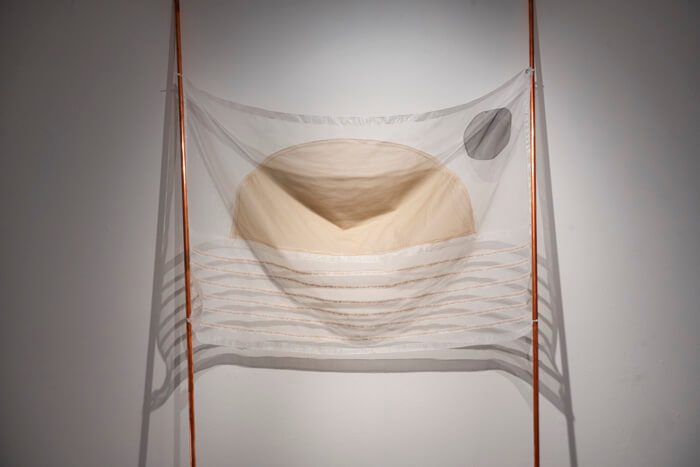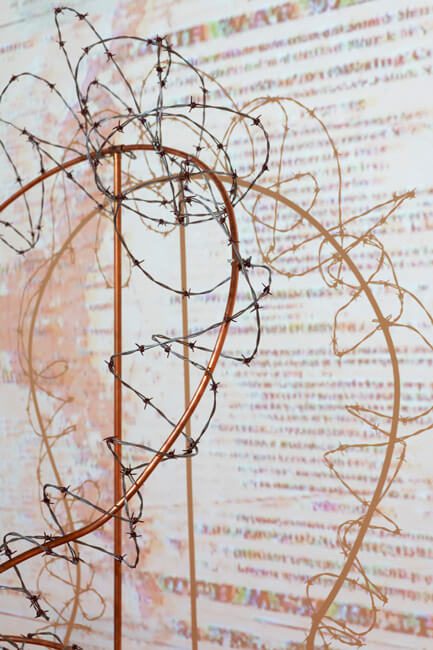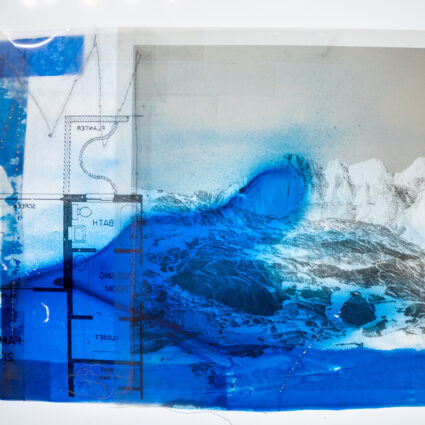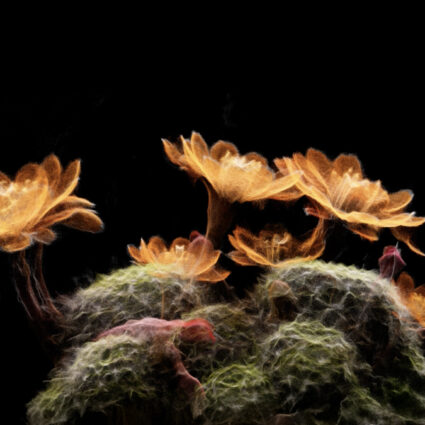Roswell, New Mexico artist-in-residence Marie Alarcón explores the revolutionary potential of the end of the world in her solo exhibition Relocations.
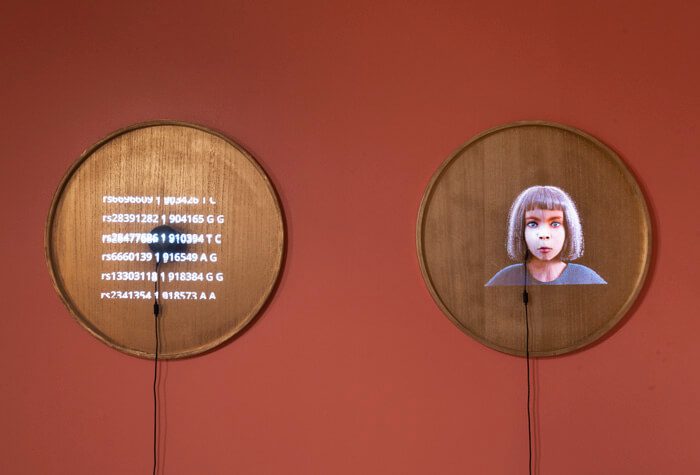
Marie Alarcón: Relocations
January 15-February 27, 2022
Roswell Museum, Roswell, New Mexico
Reflecting upon the uncertain world of climate change and the call for environmental justice, current Roswell artist-in-residence Marie Alarcón, who uses they/them pronouns, presents their solo exhibition Relocations at the Roswell Museum. With special attention to text, textiles, and video, the Philadelphia-based artist utilizes discarded industrial materials like plastic bags, hazmat blankets, barbed wire, and fiberglass to explore the material, emotional, and psychological repercussions of diasporic movement.
One large video projection, Unnamable (So Sorry), collages multiple scenes—two large trees silhouetted by a setting sun, washed-out bursts of fireworks, an adult and child (perhaps the artist’s daughter) playing in the ocean, bees pollinating a large sage bush, the Southwestern landscape, clotted clouds in the sky, and a smaller close-up of a black desert beetle crawling over sand.
This last image reappears in Sea (Lineage), a smaller video that’s projected through a circular LED fan. An avatar of a young girl—the same one from Unnamable (So Sorry)—climbs, Sesame Street-style, from the larger frame of the Southwestern landscape into the beetle’s world, hitching herself over and into its picture frame, her outline frayed with pixelation as though she might disintegrate altogether. She disappears momentarily and then pops up to face the camera as though she’s adept at navigating and manipulating digital space. In this piece, Alarcón calls forth younger, future generations by juxtaposing their sense of play in technological possibility with supposedly neutral pastoral images that feel troubled by today’s context: exhausted, uncertain, and stressed with political implication.
Two other LED fan projections add an overall whirring sound, emphasizing the sensation of breath and movement in the gallery. The second of these screen-fans plays another video of digitized numbers, a snapshot of the artist’s DNA data. Amplifying the way that artworks inform and build upon one another, this DNA text is reconfigured again in an audio soundtrack heard throughout the exhibition—an upbeat and rhythmic percussion that includes flutes and drums.
The soundtrack accompanies Roost, a video installation centered on a dauntingly useless chair constructed from barbed wire and copper. Glitched-out images project over the chair and periodically coalesce into nearly visible documents from the Spanish-American War.

Roost feels like the show’s origin story of sorts for Alarcón, who’s of Filipino, Puerto Rican, and Haitian descent. The artist asks: how does one war infiltrate the biological data within one’s body? And how does the catalyst of political agendas inform the genetics that make music, genetics passed on to subsequent generations, with the capacity to transmorph into future musics, artworks, and voices—as long as the world endures?
But the world ends, Alarcón reminds us. It is ending. And older generations have made it inhospitable. They reference this in a floor sculpture Unameable (Don’t Come) that sits like a doormat of intricately woven plastic bags, synthetic hair, and embroidery thread—non-biodegradable plastic materials. Gold letters on the surface of the mat spell, in Haitian Creole, “PALVIDA” (which translates to “don’t come”). Two flags lean against the wall, also inscribed with text—one is ivory white and mesh with fine gold letters that repeat the phrase “WHEN KNOW THEM BY THEIR,” and two circles—one large and gold, the other smaller and gray. A second dark gray and mesh flag’s composition echoes Puerto Rico’s flag and bears the repeated words “THE WORLD ENDS.” Two pendants, which include black leather hand gestures encircled with beads and shells, hang from the ceiling in a saintly arrangement.
The exhibition concludes with a reading room of books, several of which include bookmarks such as a purple hair tie and neon post-it tabs—these inserted objects cause certain pages to flip open first, offering an intimate sense of the artist’s theoretical influences. The reading room offers a resting point and an opportunity to reflect on the challenges presented by Alarcón’s rendering of the world: a site of industrial extraction whose balance of power shudders under dogged machines of production, a world unable to adapt, it seems, unable to care for its constituents. A new future lies ahead. But what will it be? And whom is it for? All of us, Alarcón insists. And the artist is right. It must be for everyone.
Marie Alarcón: Relocations continues through February 27, 2022 at the Roswell Museum, 1011 North Richardson Avenue in Roswell, New Mexico.

